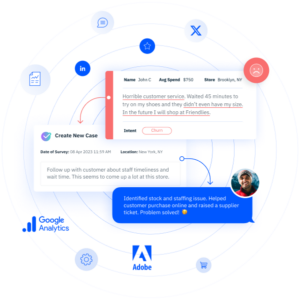Three Ways Unstructured Customer Feedback Helps You Improve Experiences

It’s no secret that businesses need unstructured customer feedback to have a successful customer experience (CX) program. Without honest, detailed criticism or praise, it’s hard to assess how well a product or service is doing, but it’s also difficult to understand the “why” and take action to improve. That’s why more and more, customers are seeing open-ended questions in surveys instead of metric-based ones: unstructured feedback can lead to a more authentic insight into the customer experience.
But how should brands harness the power of unstructured feedback in their existing surveys? And how can they take the next step of not only collecting that feedback, but derive actionable intelligence from it so they can improve experiences? Our latest eBook, “Unstructured CustomerFeedback: The Key to Unlocking the True Voice of Customer,” walks you through best practices we’ve learned from our many years of experience. This blog will spell out the major benefits of employing those best practices. Let’s get started!
Three Ways Unstructured Customer Feedback Improves Experiences
- Gathers More Genuine and Less Filtered Responses
- Collects the Missing Pieces
- Follows the Right Patterns
Benefit #1: Gathers More Genuine and Less Filtered Responses
What makes for a “good” survey? Businesses often make the mistake of only asking metric-based questions, which prompt customers to answer very specific questions in very specific ways. This leaves brands only learning what they want to learn and possibly missing other important aspects of the customer experience.
Let’s say a restaurant uses an NPS question to gauge the success of their customer experiences. The brand’s post transaction survey therefore reads, “on a scale of 1-10 how much would you recommend us?” Customers then respond with only a single number and the restaurant is left wondering why customers rate it as low as a 5. As you can see, this metric-based question can only measure the experience, and therefore fails to explain why a customer would or wouldn’t recommend the eatery.
If the restaurant had followed up the first question with an open-ended “why” question, then its feedback would include the reasoning behind the score, and would help the business understand what it needs to do to improve the CX program. With open-ended questions, brands hear the voice of customer more clearly because customers have more freedom to candidly express themselves, telling your brand what they actually want to tell you, not what you want to hear.
Benefit #2: Collects the Missing Pieces
Open-ended questions mean unpredictable and varied responses, but that’s a good thing! The feedback you receive is so much more detailed, so it can answer questions and address issues your brand wouldn’t have considered in the first place.
One of our clients, a large hotel and entertainment brand, couldn’t figure out why one of its locations was receiving such low scores from guests. This is because it was using a metric that could only see that guests were unsatisfied with their stay, but not exactly why. Through text analytics, the brand was able to analyze its unstructured data and discover that an air filtration problem was allowing smoke from the casino to enter the rooms.
By leaving survey questions open-ended, your brand not only learns the genuine opinion of customers, but also about problems it might have never known about. At the same time, feedback is not always negative; it’s important for your business to know how well it’s executing at certain touchpoints along the customer journey! These game changing pieces of intelligence can help to fill in the blanks so you have a truly holistic view of the customer experience.
Benefit #3: Follows the Right Patterns
Listening to the true voice of customer gives your business a greater capability to track common problems your customers are having over time. Your brand will then be able to identify and analyze patterns that emerge from responses and address those issues with an actionable plan.
For instance, let’s imagine that customers are having complications with your company’s website. A recent system update has caused a bug that’s disrupting functionability, leading to a seemingly random rise in customer frustration. With unstructured feedback, your brand would be able to recognize a new trend in responses, spot the platform issue, and take action to fix it.
Unstructured responses make it easier to recognize both positive and negative trends in your CX program, and also helps you to pinpoint new areas to focus on as customer expectations develop over time.
In the end, failure to employ unstructured feedback means that your CX program will have a hard time realizing its potential. Metrics alone can only measure the past; they can’t help you take action and create better experiences in the future. That’s why the stories you derive from open-ended questions are so vital to your big picture success—and to your bottomline.
Unstructured customer feedback can help your business improve customer experiences by unlocking the true Voice of Customer—but how do you best leverage that feedback in your program strategy? Read our latest eBook to read about the best practices recommended by our experts here!








